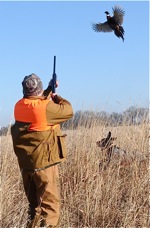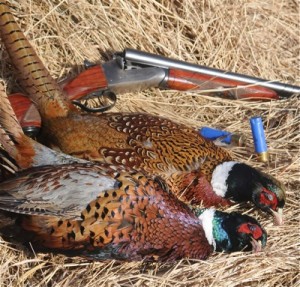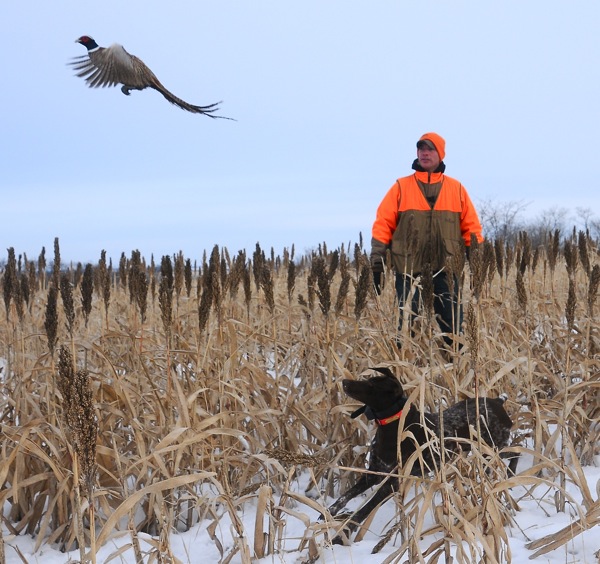If you looking for shootin’, and not just huntin’, your best bet is still to go west in search of the ringneck pheasant. If you’re determined to find birds in Ohio, the south-central part of the state seems to have had the best management success.
By Jim Abrams for Press Pros
 The ring-necked pheasant is often described as the king of gamebirds. From their raucous spring calls, their propensity to run from bird dogs, the wild, cackling burst from cover to their long gaudy tail and iridescent coloring; I can see why it received its crown.
The ring-necked pheasant is often described as the king of gamebirds. From their raucous spring calls, their propensity to run from bird dogs, the wild, cackling burst from cover to their long gaudy tail and iridescent coloring; I can see why it received its crown.
Pheasants were not originally native to Ohio; or even to the U.S. Their original strutting grounds were China and other Asian countries as well parts of Europe including the northern foothills of the Caucasus and Balkans.
While the first pheasants were brought to North America in 1773, there was little widespread propagation until the early 1800’s. The old English blackneck pheasant was also shipped to the continent but it didn’t have the vigor or rigor to survive.
The first ring-necked pheasants are credited to Owen Nickerson Denny; an Oregon native. He had 60 of the birds shipped from China to the state of Washington in 1881. While a number were lost during the voyage, more died during the rough travels to Denny’s Oregon home.
Those that survived the ordeal were released along the Columbia River where he later turned loose more birds during 1882 and 1884. The birds began to flourish in the Willamette Valley of Oregon and into Washington. In the late 1800’s and early 1900’s many were imported from English game bird farms, and released across the United States.
Today, the birds have been introduced into 40 states. While that initial release from China is noteworthy, the foundation of most wild ring-necked pheasants in the U.S. derived from those English game farm importations. In most areas of the country, they are best known by either the name “ringneck” or just “pheasant.”
The Upland Almanac has now released their annual pheasant hunting forecast for the nation. It looks like good news for much of the bird’s range. The Ohio report has hunters and their dogs hopeful that they may corner a bird or two this season.

Olde English Outfitters, in Tipp City, Ohio, proudly sponsors tales of the outdoors on Press Pros Magazine.com.
Joseph Lautenbach, wildlife biologist for the Division of Wildlife, tells us that, “Spring brought some cold, winter-like weather events and even a little snow into May. This may have reduced nest survival; however, the cold weather occurred early enough in the nesting season that hens with failed nests likely attempted a second nest. It was a nice change of pace from the past few years where Ohio has experienced flooding throughout much of the pheasant range. Pheasant brood survival is likely up.”
Cody Grasser works out of the Findlay, Ohio area and is Pheasants Forever and Quail Forever’s Senior Farm Bill Wildlife Biologist. “Thankfully, the relentless rainfall of spring and summer 2019 did not return,” Grasser said in hopes that this helped birds nesting success in the Buckeye State.
Unfortunately, much of Ohio’s habitat has fallen to the pull of agricultural equipment and many of the areas which once teamed with fall flushes have few wild birds and they’ve become something of a novelty in the game bag. As one older hunter points out, “The huntin’s good but the getten’s bad.” This situation has prompted the programs of in-season pheasant releases by the state’s wildlife division.
 Habitat remains the deciding factor on pheasant survival, numbers and harvest. “Upland habitat on public wildlife areas looks excellent going into fall,” says Lautenbach. “Ohio Division of Wildlife staff members tasked with managing these areas have done an excellent job and reports from staff seem to indicate those areas experienced good reproduction.”
Habitat remains the deciding factor on pheasant survival, numbers and harvest. “Upland habitat on public wildlife areas looks excellent going into fall,” says Lautenbach. “Ohio Division of Wildlife staff members tasked with managing these areas have done an excellent job and reports from staff seem to indicate those areas experienced good reproduction.”
Unfortunately, Ohio has continued to see private land decrease in enrollments in the important soil and water conservation programs, especially the Conservation Reserve Program (CRP). One exception has been the Scioto River Conservation Reserve Enhancement Program (CREP) which recently opened for reenrollment. Proof of the importance of reestablishing habitat for wildlife is easy to find in that mid-Ohio area.
“Ohio’s pheasant stronghold is in the central and southern parts of the state along the Scioto River watershed,” advises Grasser. “The Scioto CREP plays a large part in supporting pheasants in this area through enrollment of private lands into the program to establish and maintain native grassland habitat. Management requirements in this program help ensure the habitat is of good quality to benefit wildlife.”
Nesting and brood counts have responded to these improvements and Grasser tells us that biologists are seeing the results. They’ve flushed birds while working and surveying projects in the area and heard the cackling call of roosters throughout the spring.
 Lautenbach agrees. “Crow counts indicated that the pheasant population is similar to last year. I have heard some nice reports of broods from landowners enrolled in the Scioto River CREP.”
He acknowledges that populations are not as high as past decades but that there are still some pockets of excellent habitat that can yield a high-quality hunt.
Lautenbach agrees. “Crow counts indicated that the pheasant population is similar to last year. I have heard some nice reports of broods from landowners enrolled in the Scioto River CREP.”
He acknowledges that populations are not as high as past decades but that there are still some pockets of excellent habitat that can yield a high-quality hunt.
Both of these pheasant experts agree that your best bet is to try the Scioto River corridor and also checking out Ross, Pickaway, Madison and Fayette counties where CRP and CREP programs are strong. These areas have publicly managed upland areas but remember that private lands are off-limits unless you get written permission to hunt.
Lautenbach suggests some areas to try including one in fare Northwest, Ohio. “Visiting Deer Creek Wildlife Area and nearby Wildlife Production Areas in south-central Ohio can be very productive. Big Island Wildlife Area in Marion County and Lake La Su An Wildlife Area in Williams County are both popular destinations for pheasant hunters in Ohio. Both wildlife areas provide large blocks of grass interspersed with wetlands and crops.”
 Visit the Ohio Division of Wildlife website at https://ohiodnr.gov/ and follow the “Documents and Publications” tab to find maps for Ohio’s public wildlife areas as well as lakes and reservoirs.
Visit the Ohio Division of Wildlife website at https://ohiodnr.gov/ and follow the “Documents and Publications” tab to find maps for Ohio’s public wildlife areas as well as lakes and reservoirs.
To read the Upland Almanac’s complete pheasant forecast for the nation, visit https://uplandalmanac.com/2020-pheasant-forecast or you can find their magazine in many local stores. If you love the smell of autumn’s leaves and wet bird dogs, pick up a copy.
You might also consider joining Pheasants Forever. They truly are the habitat organization and as I’ve often said, habitat is the key to wildlife. Visit their informative website at https://pheasantsforever.org and get involved.
Ohio’s statewide small game season opens Nov. 6.
“The best thing about hunting and fishing,” the Old Man said, “is that you don’t have to actually do it to enjoy it. You can go to bed every night thinking about how much fun you had twenty years ago, and it all comes back clear as moonlight.” — Robert Ruark, ‘The Old Man and the Boy’
Jim Abrams is a retired wildlife officer supervisor for the state Division of Wildlife in Findlay. He can be reached at P.O. Box 413, Mount Blanchard, OH 45867-0413 or via e-mail at jimsfieldnotes@aol.com.

Coverage of the outdoors on Press Pros is proudly sponsored by Olde English Outfitters, in Tipp City.

